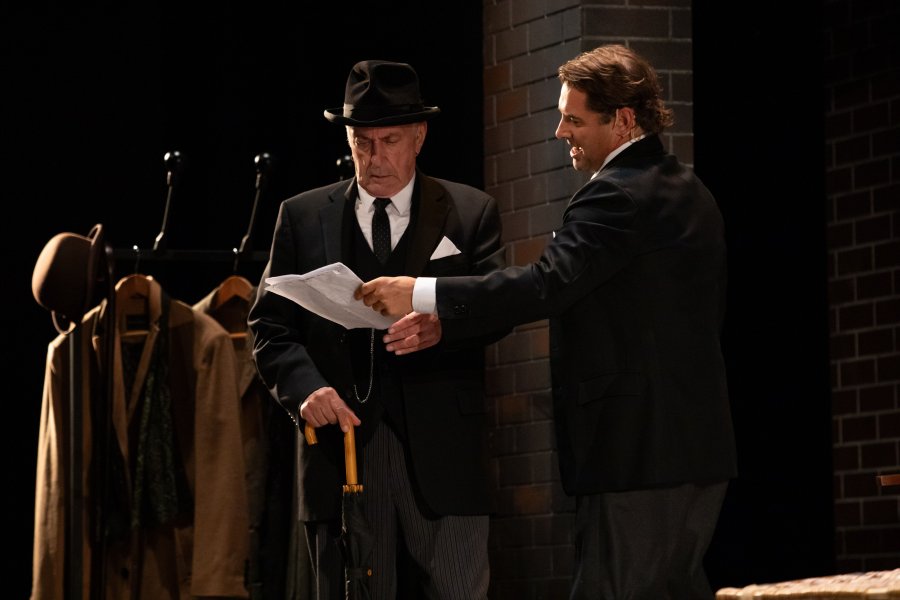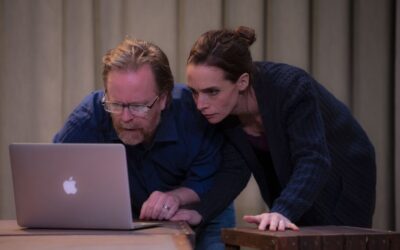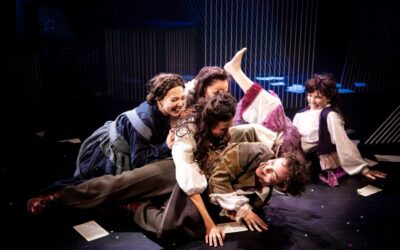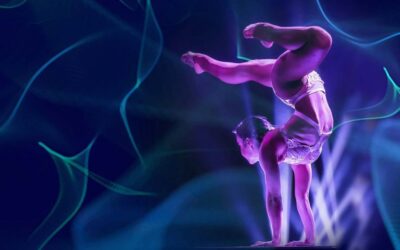By Kellie Warner
After a thirty-year run in the West End in London, the acclaimed psychological thriller, The Woman in Black graced the stage at QPAC in Brisbane last Thursday for its opening night. The highly acclaimed ghost story is considered scary by some and horrifying by others. Either way, the consensus is that this is not a show for the faint-hearted.
Adapted by Stephen Mallatratt from the novel by Susan Hill, the play is considered a prime example of horror and gothic writing, and the stage play adaptation is one of the most terrifying performances to ever appear on stage.
This production directed by Robin Herford, who directed the original production back in 1987 features Australian acting royalty with John Waters as Arthur Kipps, and Daniel Macpherson as The Actor. A veteran of stage and screen, Waters brings a stoic, fierceness to Kipps and Macpherson has the same charm and confidence as the character he plays.
The Woman in Black tells the story of Arthur Kipps, too frightened to tell his family about a terrifying encounter he experienced as a young man, he hires an actor to help him. The young, charismatic actor happily takes on the role of Kipps in their performance, while Kipps himself, after a few false starts, plays the parts of everyone he encountered during his ordeal all those years ago.

The play has been a roaring success and is second only to The Mousetrap when it comes to the longest-running plays in the West End. With that level of reputation, there is a certain anticipation you feel when heading into the theatre and spotting the almost barren stage with the iconic wicker basket front and centre. The long, deceptively dark sheets of cloth hang ominously and at a glance resemble a ghostly spectre. A shiver and a few goosebumps might well be had before a word of the play is uttered.
The play is famous as much for its simplicity as its ability to frighten. A bare stage, a few props and just two actors (three if you count the fleeting appearances of the black-clad woman herself.) Plenty of theatregoers might think this was done deliberately to narrow the spotlight purely on the story itself, rather than trying to focus as we take in fancy sets, costumes, and different actors dashing on and off the stage.
Now while this absolutely is the case, Mallatratt did not set out to write a simple stage play out of some sense of minimalism as an art form. But rather he was confined by budget restraints, and The Woman in Black play as we know it was born. A play with just two actors, but many parts. A play within a play. A young, brilliant but possibly out-of-work actor defending his lack of props to Kipps exclaiming that a wicker basket really could be used for so many things.
Oddly enough, the play starts with quite a bit of humour. Kipps is no performer (hence why he needs the services of The Actor) and initially reads his tale in a robotic voice, looking downcast. After this initial fumbling, The Actor takes pity on Phipps and turns him into a fully-fledged actor by giving him a seemingly innocuous pair of spectacles.
The Actor takes pride in how Kipps turns into a brilliant thespian, changing roles at the drop of a hat (pun very much intended), complete with accent. All it took was a pair of magic glasses. If only it were that simple to gain the performance genius of John Waters.
A play such as this is a true treat for times like ours where we have so much over-the-top entertainment available to us at every turn. This play makes us think and use that wonderful resource we all have as human beings, imagination.
With so little to work with in terms of backdrop and props, we must engage all our senses to immerse ourselves in the story. It is cold in the theatre, there are times of bright light and ominous darkness. There are deafening periods of silence and blood-curdling screams echoing through the theatre.
There are tricks of the light, and the dark backdrop becomes opaque to reveal the secrets of the locked room. It is all smoke and mirrors, sounds, and shapes, darkness, and light. Kipps changes from a wealthy landowner, Mr. Samuel Daily to the different villagers through a change in coat, hat, and demeanor.
Much of the action takes place at Eel Marsh House with The Actor portraying the once young and innocent Kipps going through all the correspondence and papers belonging to Mrs Drablow, with just a dog named Spider for company. Here he experiences more ghostly encounters and experiences horrors he hadn’t been able to speak of for years.
Kipps leaves the shelter of the house to go outside. Darkness descends as a thick fog settles over the bleak marshes, with just a blinding light from a torch, and the need to shield your eyes becomes overpowering. But an emaciated woman clad in black is hovering in wait and so we must allow our eyes to adjust so we can find the way back to the house and breathe once more.
As the two characters rehearse Phipps must deal head-on with this and other encounters he experienced at the house, just as The Actor, seemingly unaware of any danger, grows more and more confident playing his role.
However, we are reminded at times that both Kipps and The Actor are role-playing. They change gears back and forth with ease, a click of fingers and a change in lighting bring forth their real personas.
There was an especially clever scene that identifies how Kipps is suffering through the re-telling and that The Actor becomes aware of this. Kipps as the frightened Mr. Jerome makes an exclamation of fear so full of anguish that The Actor immediately recognises it for what it is, Kipps himself crying out and The Actor breaks character to check on him.
Given that the West End production often featured the same two actors working together for some length, such as the first-rate combination of Julian Forsythe and Antony Eden, the fact that Macpherson and Waters’ performances are so in sync with each other is a testament to their abilities.
Waters and Macpherson have great chemistry which produces a master class in acting. Here is a wicker basket, a few hats, and jackets, now tell me a story. Tell that story, they did, quite brilliantly.
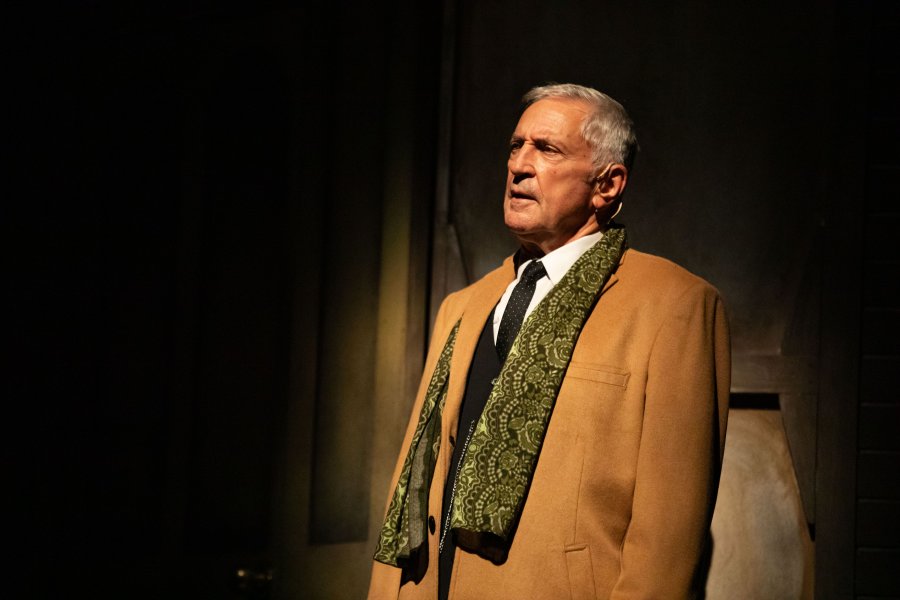
Macpherson as a terrified Kipps banging on a locked door and screaming in terror and frustration is something to behold.
They both work brilliantly with the props, moving up and down and side to side as the wicker basket becomes a trap being pulled by a pony. They manage to appear entirely serious and truly come into their own as they lean down to scratch the ears of an invisible and silent dog.
Overall, as a theatre experience, this play will stay with you for some time. It is superbly crafted, brilliantly acted and possibly nightmare-inducing! While much of the plot needs to stay under wraps in case anyone reading this doesn’t know what to expect let me just say that the ending will make you gasp.
The Woman in Black is playing at The Playhouse, QPAC until May 11th
For more information visit thewomaninblack.com.au
For tickets visit QPAC
Images: Justin Nicholas

